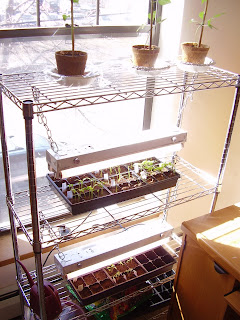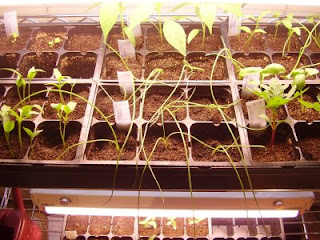Some of the trees directly outside of my apartment are just starting to get small leaves. And the grass is getting a little greener, but not growing much yet. The same is true for my cabbages and onions outside. While they're still alive, they haven't grown much yet. The seeds I planted outside (spinach, carrots, radishes, and lettuce) have germinated with the exception of the slower carrots. But they haven't moved past the seed leaf stage yet.
Meanwhile, inside, my plants are growing faster than before. It was sunny and windy this week. I left the window open and the wind blew my peppers over. They are recovering nicely and are, hopefully, stronger due to the wind stress.

Tomatoes.

Peppers, tomatoes, and okra.
I planted marigold seeds that were from last year's garden. In hindsight, I really didn't NEED to plant them indoors since they germinate so quickly. But, what a delight to have marigolds blooming under my grow lights! The photographs do not do the vibrant colors justice.

Marigolds and basil.

Marigold.

Marigold.
My okra has been another suprisingly delightful plant. The seedlings are beautiful with red stems and fuzzy leaves. They also grow quickly.

Okra.

Okra.


























